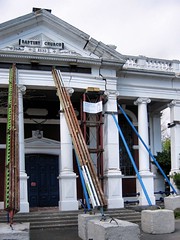
Search
Images for Canterbury Earthquake; more images...
Shirley Community Centre, Shirley
Images, eqnz.chch.2010
Shirley Community Centre, Shirley Road, Christchurch. File reference: CCL-2012-05-10-Around-Shirley-May-2012 DSC_02863.JPG From the collection of Christchurch City Libraries.
Shirley Community Centre, Shirley
Images, eqnz.chch.2010
Shirley Community Centre, Shirley Road, Christchurch. File reference: CCL-2012-05-10-Around-Shirley-May-2012 DSC_02867.JPG From the collection of Christchurch City Libraries.
On-going challenges in physics-based ground motion prediction and insights…
Research papers, University of Canterbury Library
This paper presents on-going challenges in the present paradigm shift of earthquakeinduced ground motion prediction from empirical to physics-based simulation methods. The 2010-2011 Canterbury and 2016 Kaikoura earthquakes are used to illustrate the predictive potential of the different methods. On-going efforts on simulation validation and theoretical developments are then presented, as well as the demands associated with the need for explicit consideration of modelling uncertainties. Finally, discussion is also given to the tools and databases needed for the efficient utilization of simulated ground motions both in specific engineering projects as well as for near-real-time impact assessment.
Di Madgin's Red Zone photograph 6
Images, UC QuakeStudies
A scanned copy of a photograph of the garden of Di Madgin's former home in the Red Zone, taken before the earthquakes.
Di Madgin's Red Zone photograph 4
Images, UC QuakeStudies
A scanned copy of a photograph of the garden of Di Madgin's former home in the Red Zone, taken before the earthquakes.
011
Images, eqnz.chch.2010
Shipping containers against the cliff on the road to Sumner, Christchurch. File reference: CCL-2012-05-12-Around-Sumner-May-2012 DSC_011.JPG From the collection of Christchurch City Libraries.
At the top of the cliff, Sumner
Images, eqnz.chch.2010
Damaged house on the cliff on the road to Sumner, Christchurch. File reference: CCL-2012-05-12-Around-Sumner-May-2012 DSC_019.JPG From the collection of Christchurch City Libraries.
Kirkwood Village University of Canterbury Photograph 3
Images, UC QuakeStudies
A photograph of Kirkwood Village, a cluster of temporary classrooms and offices constructed at the University of Canterbury campus following the 22 February 2011 earthquake.
Kirkwood Village University of Canterbury Photograph 5
Images, UC QuakeStudies
A photograph of Kirkwood Village, a cluster of temporary classrooms and offices constructed at the University of Canterbury campus following the 22 February 2011 earthquake.
Kirkwood Village University of Canterbury Photograph 2
Images, UC QuakeStudies
A photograph of Kirkwood Village, a cluster of temporary classrooms and offices constructed at the University of Canterbury campus following the 22 February 2011 earthquake.
Kirkwood Village University of Canterbury Photograph 1
Images, UC QuakeStudies
A photograph of Kirkwood Village, a cluster of temporary classrooms and offices constructed at the University of Canterbury campus following the 22 February 2011 earthquake.
Original central library pre demolition 002
Images, eqnz.chch.2010
Canterbury Public Library viewed from near the Bridge of Rememberance,
St Stephens Anglican Church, Shirley
Images, eqnz.chch.2010
St Stephens Anglican Church, Shirley Road, Christchurch. File reference: CCL-2012-05-10-Around-Shirley-May-2012 DSC_02857.JPG From the collection of Christchurch City Libraries.
St Stephens Anglican Church, Shirley
Images, eqnz.chch.2010
St Stephens Anglican Church, Shirley Road, Christchurch. File reference: CCL-2012-05-10-Around-Shirley-May-2012 DSC_02858.JPG From the collection of Christchurch City Libraries.
St Stephens Anglican Church, Shirley
Images, eqnz.chch.2010
St Stephens Anglican Church, Shirley Road, Christchurch. File reference: CCL-2012-05-10-Around-Shirley-May-2012 DSC_02859.JPG From the collection of Christchurch City Libraries.
St Stephens Anglican Church, Shirley
Images, eqnz.chch.2010
St Stephens Anglican Church, Shirley Road, Christchurch. File reference: CCL-2012-05-10-Around-Shirley-May-2012 DSC_02856.JPG From the collection of Christchurch City Libraries.
St Stephens Anglican Church, Shirley
Images, eqnz.chch.2010
St Stephens Anglican Church, Shirley Road, Christchurch. File reference: CCL-2012-05-10-Around-Shirley-May-2012 DSC_02860.JPG From the collection of Christchurch City Libraries.
St Stephens Anglican Church, Shirley
Images, eqnz.chch.2010
St Stephens Anglican Church, Shirley Road, Christchurch. File reference: CCL-2012-05-10-Around-Shirley-May-2012 DSC_02855.JPG From the collection of Christchurch City Libraries.
BeckerFraserPhotos April 2011 photograph 117
Images, UC QuakeStudies
The entrance of the Canterbury Museum, closed after the 22 February 2011 earthquake. Damage to the top of the gables is visible.
BeckerFraserPhotos April 2011 photograph 118
Images, UC QuakeStudies
The entrance of the Canterbury Museum, closed after the 22 February 2011 earthquake. Damage to the top of the gables is visible.
BeckerFraserPhotos July 2011 photograph 661
Images, UC QuakeStudies
A photograph of an earthquake-damaged building on the corner of Canterbury and London Streets in Lyttelton.
Decision-Making for Resilient Solutions Associated with Heritage, Earthqua…
Research papers, University of Canterbury Library
he 2016 Building (Earthquake Prone Building) Amendment Act aims to improve the system for managing earthquake-prone buildings. The proposed changes to the Act were precipitated by the Canterbury earthquakes, and the need to improve the seismic safety of New Zealand’s building stock. However, the Act has significant ramifications for territorial authorities, organisations and individuals in small New Zealand towns, since assessing and repairing heritage buildings poses a major cost to districts with low populations and poor rental returns on commercial buildings.
20100906-114114.jpg
Images, eqnz.chch.2010
None
Di Madgin's Red Zone photograph 7
Images, UC QuakeStudies
A scanned copy of a photograph of a bench in the garden of Di Madgin's former home in the Red Zone, taken before the earthquakes.
Damage to the Librarian's house
Images, eqnz.chch.2010
The original City Librarian's house at Canterbury Public Library. File reference: CCL-2011-08-12-CanterburyPublic Library pre-demolition-002 From the collection of Christchurch City Libraries.
Approved Tunnel Travel Permit
Images, eqnz.chch.2010
Photos taken in Lyttelton following the February 22 earthquake. Permit authorised by commanding officer HMNZS Canterbury. File ref: CCL-2011-03-05-After-The-Earthquake-P1110452 From the collection of Christchurch City Libraries
Paul and Sam Corliss's Street Art Photograph (2009:10:12 02:15:54)
Images, UC QuakeStudies
A photograph of street art in the Addington Saleyards, taken before the Canterbury earthquakes. The artist is Fiasco.
Photograph by Paul Corliss 0125
Images, UC QuakeStudies
A photograph of a sign reading, "Emergency, campus closed, no entry". The photograph is captioned by Paul Corliss, "Canterbury University post earthquake".
sand volcano in our front lawn
Images, eqnz.chch.2010
The earthquake knocked over the bird bath.
sand volcano
Images, eqnz.chch.2010
Debra points at the beginnings of a sand volcano not long after the big earthquake.



